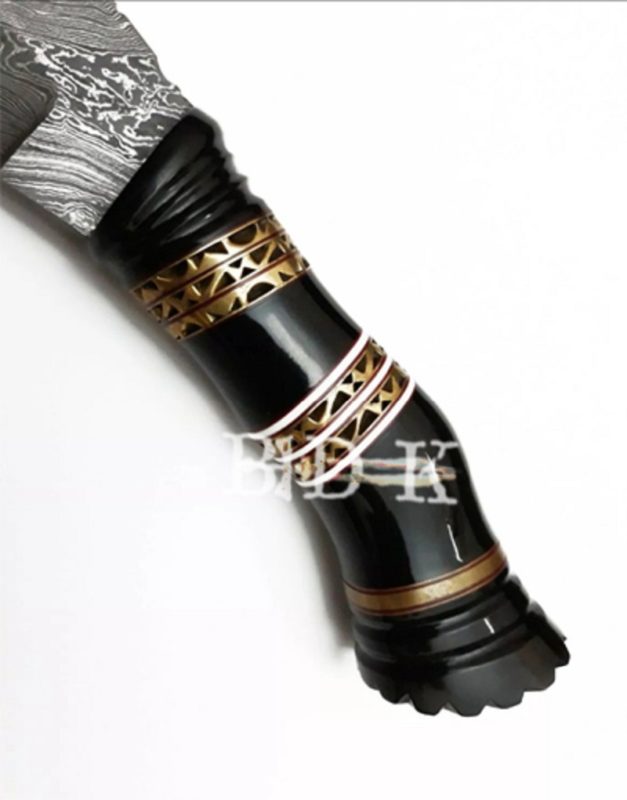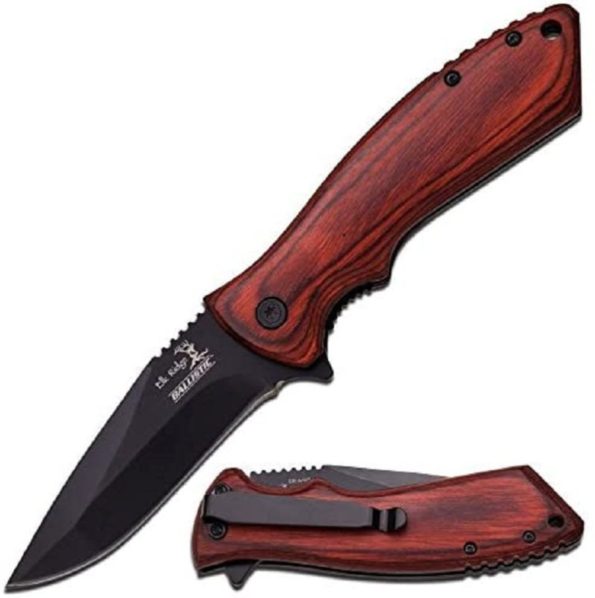Are you wondering How To Make A Knife Handle? do not bother yourself more your hunt is closed you are at the right place we at BestDamascusKnife giving you guidance on How To Make A Knife Handle. There is a true beauty to handcrafted knife handles. The method of producing custom knife handles may need a while, but it is simple once you understand what to do. Best of all, you can have a wonderful custom knife to show off at the end.
How To Make A Knife Handle: Part1

How To Make A Knife Handle Part1
Making the Base and Elements
1: Create or obtain a full-tang knife blade. A full-tang knife blade comprises a metal blade and a simple metal handle. The handle (tang) section should be previously cut in the appearance of the wood handle (scale).
-
- You can purchase knife kits online that hold just the full-tang blade and pins.
2: Wrap 3 coats of tape throughout the blade section of your knife. Pipe tape or electrical tape will serve the most suitable. You can apply masking tape, but you will lack to apply more coats. Cover the tape from the top of the knife down to the base, where the blade finishes. Do not coat the tang.
-
- Make assured that the tape thoroughly coats the blade. This will decrease the possibilities of the knife cutting you, or of epoxy going on the blade.
-
- The tape will not just save you from getting wounded while you work but further defend the blade from getting chipped or scratched.
- If you can yet feel the blade by the tape, just wrap more tape throughout the blade.
3: Get two 1⁄4-in (0.64-cm) pieces of wood for the scales. Pick a powerful, enduring wood that is approximately 1⁄4-in (0.64-cm) thick, and a few larger than the tang. For a more refined finish, guarantee that the grain runs onward the length of the wood. You can purchase these pieces online from shops that train in knife-making supplies.
-
- A knife handle is made of 2 halves, which are additionally recognized as “scales.” The tang is sandwiched within the scales.
-
- Numerous kinds of wood to work with include: apple, ash, bois d’arc, hickory, peach, pear, and pecan.
- Hardwoods arise from deciduous trees and are typically extra long-lasting than softwoods, which arise from coniferous trees.
4: Cut the pins, if needed. If you bought a knife kit, the pins may previously be cut for you. If you did not buy a kit, you will necessitate cutting the metal rod into 1 in (2.5 cm) lengths. Set the rod down on a solid surface, then apply a metal saw or file to cut it into 1 in (2.5 cm) lengths.
-
- How many bars you cut depends on how many holes are in the tang. Some knives have 2 holes while others have 4.
-
- The metal rod requires to be thin enough to fit into the holes in the tang. The diameter of the rod ranges from knife to knife.
5: File down the ends of the pins, if needed. Once repeatedly, if you bought a kit, the pins should previously be filed down for you. If you cut the pins yourself, there will possibly be sharp burs on each end. File these down utilizing a metal file or grinder.
-
- Do not bother if the outcomes of the pins are not well flat. You will be filing them down later so that they are level with the scales.
6: Line your clamp or braces with plywood and plastic wrap. You would not be utilizing this continuously you can glue everything mutually. Epoxy glue sets fast, though, so it would be a great plan to have everything ready. Join a piece of plywood on per side of your vise. Wrap a sheet of plastic wrap, then tuck it among the vises, like a taco.
-
- Apply a heavy-duty table-mounted vise, if attainable. If you do not have that, use 2 to 3 more miniature vises rather.
-
- The plywood will defend the wooden scales from becoming depressed by the vises.
- The plastic cover will hold the epoxy glue from going everywhere. If you do not have that, you can try wax paper alternatively.
How To Make A Knife Handle: Part2
Drilling the Pin Holes
1: Tape the scales and tang collectively. Pile the scales collectively with the sides you need to be on the outside of the handle facing out. Place the tang on the head, then cover a piece of masking tape throughout the center to hold everything collectively.
-
- Be cautious not to coat the holes in the tang. If the scales and tang wobble, cover the second section of tape throughout the end of the tang and scales.
- Masking tape will operate the most useful here because it has a stronghold but leaves a small residue.
2: Utilize a drill press to create the first hole applying the tang’s holes as a guide. Place the knife down on your drill plate, with the tang meeting up. Enter the drill piece into 1 of the holes in the tang. Begin the drill and push down on it, making assured to go by both scales. Stop the drill press and lift the bit out.
-
- You may get this most comfortable to do with a drill press, but a handheld drill may do the work
3: Insert a pin into the hole, then do the remaining holes. If your tang has 4 holes in it rather than 2, drill the second hole diagonal from the beginning. Enter the pin, then drill the remaining 2 holes, working diagonally. Enter the pins as quickly as you complete the holes.
-
- Drilling the holes and entering the pins 1 at a time will additionally lessen the risks of the tang and scale from shifting.
-
- Use a hammer to hit the pins in.
4: Dismiss the tape and trace the tang onto the scales. Uncover the piece of tape off, but leave the pins and tang in position. Draw throughout the tang with a marker.
-
- It does not matter if you utilize a washable or lasting marker. You will finally sand this off.
5: Remove the tang and cut the scales. Raise the tang away, but leave the pins inside the scales. Apply a band saw or a scroll saw to cut the scales just outside the line that you drew. You will sand the scales to match the tang later.
-
- You are cutting by both scales at the identical time. The pins will keep the scales collectively.
6: Sand and polish the top edge of the scales. After you meet the knife handle, you would not be capable to dust and polish the first narrow edge that meets the base of the blade. The blade will go in the way, therefore it is most satisfying to do this now. Just tape the scales collectively, then sand and polish the top edge as wanted.
-
- Utilize a belt sander to shape the edge. Sand the edge down with 220- and 400-grit sandpaper. Complete off with a shield.
-
- It would be an also more suitable approach to enter the pins into the scales. This will assure that the scales are arranged and balanced.
How To Make A Knife Handle: Part3
Gluing the Scales
1: Clean the tang on both sides to eliminate any oils or dirt. You can apply window cleaner or cleaning alcohol. Just wipe the tang down with your aspired solution, and allow it dry. Be cautious not to handle the tang with your bare hands after this.
-
- Rubbing alcohol will serve the most useful, but you can utilize window cleaner too.
- You do not have to wipe the wood scales. The wood is acceptable and textured, therefore it will use the epoxy immediately.
2: Scuff the tang on both sides to provide the epoxy some texture to attach to. You can do this with a metal file or also a screw. You do not have to be careful about this step, but you should clean the surface down once you are finished.
-
- If the scales are even on the marked sides, it would be a great approach to scuff them as well.
-
- You can additionally approximately sand the scales with 120-grit sandpaper. Make assured that you are simply sanding the sides that will be touching the tang.
3: Adjust the epoxy glue according to the directions. Each brand of epoxy glue is changed, but in most maximum cases, you will necessitate mixing equivalent amounts of “Part A” and “Part B” in a plastic, disposable cup. Work swiftly. Most maximum epoxy glues are set within minutes.
-
- Make assured that you are applying epoxy glue, and not epoxy resin or cover.
-
- Combine the epoxy utilizing a disposable instrument, as it will ruin whatever you apply to stir it. It would be a great concept to wear some plastic vinyl gloves too.
- You can purchase epoxy glue in appliance stores. Some craft shops may additionally sell epoxy glue
4: Glue the original scale to the tang with the provided epoxy. Apply a disposable knife or paint spatula to reach an even coat of epoxy onto 1 side of the tang and the marked side of the matching scale with epoxy. Press the 2 collectively.
5: Insert the pins and glue the second scale. Acting swiftly, flip the knife over so that you can view the other side of the tang. Enter the pins into the holes. Cover the tang and the sealed side of the left scale, and press them collectively.
-
- You may have to hit the second scale into position to assure a tight fit.
-
- If you need to, you can cover the pins with epoxy too. This will make the relationship also more powerful.
6: Enter the handle into the vise and clamp it shut. Make assured that you are entering the handle within the pieces of plastic wrap–this way, the excess epoxy would not get everywhere. Close the vise as tightly as potential.
7: Wipe off any excess epoxy with a rag soaked in acetone. After removing the 2 halves collectively, all the excess epoxy will have flowed out. Soak a rag in acetone, and apply it to wipe off any epoxy that has flowed out from between the 2 scales.
8: Enable the epoxy to set. How large this takes depends on the kind of epoxy you are applying. Some are installed and available to apply within 1 hour. Others require up to 1 day to dry. Review the label on your package of epoxy for comprehensive drying times and directions.
How To Make A Knife Handle: Part4
Finishing the Handle
- Take the knife out of the vise. Once the epoxy has hardened, loosen the vise and pull the knife out. Do not separate the tape from the blade just yet.
- Grind off the excess pins, if needed. Utilize a belt sander or grinder to eliminate any excess pins that are holding out of the surface of the scale. You need them to be level with the scale.
- Carve and shape the handle with a belt sander. Continue sanding the scales till you reach the metal section of the tang. If you have any lines leftover from when you discovered the tang onto the scales, be assured to sand that off too. At this point, you can further sand the edges of the handle so that they are extra rounded and convenient to hold.
- Sand and polish the scales. Start sanding the scales with 220-grit sandpaper. Once the wood is soft, go onto 400-grit sandpaper. End off with a buffer till the scales are polished to your liking.
- Seal the handle, if desired. For an even more refined finish, you can use 1 layer of de-waxed shellac and 2 layers of an oil-based polyurethane sealer. Buff the finish after it dries. How large the finish needs to dry depends on the brand that you are utilizing, therefore read the label thoroughly. This can take anywhere from a few hours to a few days.
- Remove the tape from the blade. Your knife is presently complete and available to use. If you see any epoxy on the blade, you can rub it off with a craft blade, but make assured that you go simultaneously the length of the blade. You can additionally try dissolving it with acetone
Editor’s Recommendations
- How Tall Is A Kitchen Table
- How To Make A Knife Sheath
- How To Fight With A Knife
- How to Use a Knife for Self Defense
- What is Kydex
- How Should Hiking Boots Fit
- How to Wash Hiking Boots
- How to Hold a Sword


